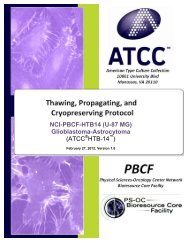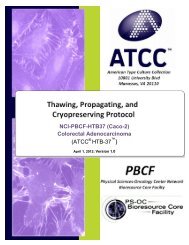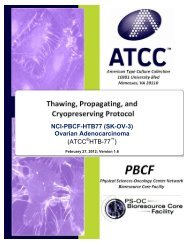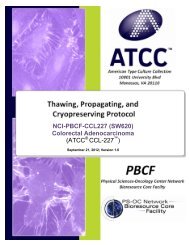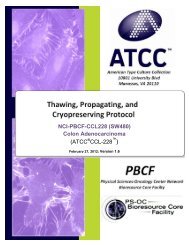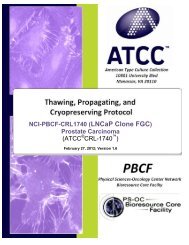ZR-75-1
ZR-75-1
ZR-75-1
Create successful ePaper yourself
Turn your PDF publications into a flip-book with our unique Google optimized e-Paper software.
SOP: Thawing, Propagation and Cryopreservation of NCI-PBCF-CRL1500<br />
(<strong>ZR</strong>-<strong>75</strong>-1)<br />
b. Propagating cells<br />
Method:<br />
1. Add 9 mL of complete growth medium (RPMI 1640 + 10 % (v/v) FBS) to a 15-mL<br />
conical centrifuge tube.<br />
2. Again wipe the outer surface of the vial with sterile gauze wetted with 70 % ethanol.<br />
3. Using sterile gauze, carefully remove the cap from the vial.<br />
4. With a 1 mL pipette transfer slowly the completely thawed content of the vial (1 mL<br />
cell suspension) to the 15-mL conical centrifuge tube containing 9 mL complete<br />
growth medium (RPMI 1640 + 10 % (v/v) FBS). Gently resuspend cells by pipetting<br />
up and down.<br />
5. Centrifuge at 125 xg, at room temperature, for 8 min to 10 min.<br />
6. Carefully aspirate (discard) the medium, leaving the pellet undisturbed.<br />
7. Using a 10 mL pipette, add 10 mL of complete growth medium (RPMI 1640 + 10 %<br />
(v/v) FBS).<br />
8. Resuspend pellet by gentle pipetting up and down.<br />
9. Using a 1 mL pipette, remove 1 mL of cell suspension for cell count and viability. Cell<br />
counts are performed using either an automated counter (such as Innovatis Cedex<br />
System; Beckman-Coulter ViCell system) or a hemocytometer.<br />
10. Record total cell count and viability. When an automated system is used, attach<br />
copies of the printed results to the record.<br />
11. Plate cells in pre-labeled T-25 cm 2 flask at about 5 x 10 4 viable cells/cm 2 .<br />
12. Transfer flask to a 37 °C ± 1 °C in 5 % CO 2 incubator if using flasks with vented caps<br />
(for non-vented caps stream 5 % CO 2 in the headspace of flask).<br />
13. Observe culture daily by eye and under an inverted microscope to ensure culture is<br />
free of contamination and culture has not reached confluence. Monitor, visually, the<br />
pH of the medium daily. If the medium goes from red through orange to yellow,<br />
change the medium.<br />
14. Note: In most cases, cultures at a high cell density exhaust the medium faster<br />
than those at low cell density as is evident from the change in pH. A drop in<br />
pH is usually accompanied by an increase in cell density, which is an indicator<br />
to subculture the cells. Cells may stop growing when the pH is between pH 7<br />
to pH 6 and loose viability between pH 6.5 and pH 6.<br />
15. If fluid renewal is needed, aseptically aspirate the complete growth medium from the<br />
flask and discard. Add an equivalent volume of fresh complete growth medium to<br />
the flask. Alternatively, perform a fluid addition by adding fresh complete growth<br />
medium to the flask without removing the existing medium. Record fluid change or<br />
fluid addition on the Cell Line Expansion Table (see Table 5 in Appendix 6).<br />
16. If subculturing of cells is needed, continue to ‘Subculturing cells’.<br />
Page 7 of 24





